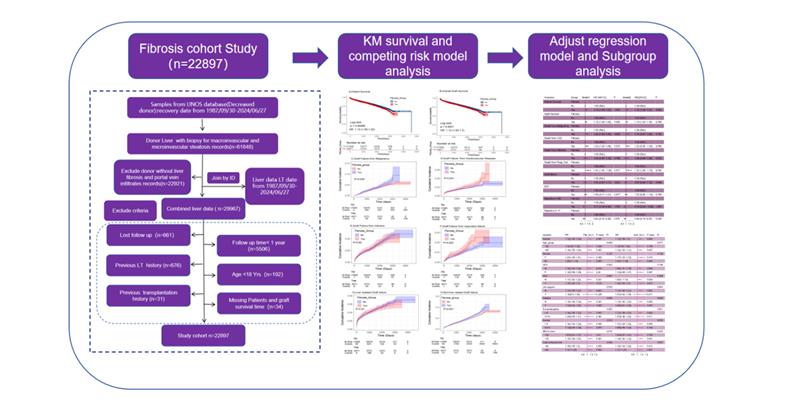Preprint
Article
The Impact of Donor Liver Fibrosis on the Outcomes of Patients Who Undergo Liver Transplant: A Cohort Study from Unos Database
Altmetrics
Downloads
10
Views
8
Comments
0
This version is not peer-reviewed
Advances in Gastrointestinal and Liver Disease: From Physiological Mechanisms to Clinical Practice
Submitted:
20 November 2024
Posted:
22 November 2024
You are already at the latest version
Alerts
Abstract
AbstractBackground: The increasing prevalence of fibrosis in donor livers raises concerns about its impact on post-transplantation outcomes, though this relationship remains unclear. This study aims to assess the effect of donor liver fibrosis on patient and graft survival following liver transplantation.Methods: Data from the UNOS-STAR registry (1987–2024) were analyzed, focusing on patients who received liver transplants with biopsy-proven fibrosis. The cohort was stratified based on fibrosis grade, and outcomes were compared using Cox regression and Kaplan-Meier survival analysis. Competing risk models were applied to assess specific mortality causes, and subgroup analyses explored the sensitivity of fibrosis on transplant outcomes.Results: Of the 22,897 patients, 17,926 received non-fibrotic grafts, and 4,971 had grafts with varying fibrosis grades. Donor fibrosis was associated with donor age, steatosis, and portal infiltrate, generally affecting those in better overall condition. Significant differences were observed in patient survival (p=0.001) and graft survival (p=0.002) between the fibrosis and non-fibrosis groups. Further analysis revealed that fibrosis increased the risk of malignancy (p=0.028), cardiovascular disease (p=0.017), and respiratory failure (p=0.033), but showed lower rejection rates at six months and one year. Sensitivity analyses confirmed fibrosis as an independent risk factor, with varying effects in subgroups.Conclusion: Donor liver fibrosis significantly impacts post-transplant outcomes, notably increasing the risk of all-cause mortality and graft failure. Specific causes of death, such as malignancy and cardiovascular disease, were more prevalent in recipients of fibrotic grafts, highlighting the need for further research to refine donor selection criteria.

Keywords:
Subject: Medicine and Pharmacology - Clinical Medicine
Copyright: This open access article is published under a Creative Commons CC BY 4.0 license, which permit the free download, distribution, and reuse, provided that the author and preprint are cited in any reuse.
Immune Responses of Anti-HCV Antibody after Direct-Acting Antiviral Therapy Associated Allograft Injury with Acute Jaundice in Patients underwent Liver Transplantation
Shu-Hsien Lin
et al.
,
2023
Everolimus Mitigates the Risk of Hepatocellular Carcinoma Recurrence after Liver Transplantation
Paolo De Simone
et al.
,
2024
MDPI Initiatives
Important Links
© 2024 MDPI (Basel, Switzerland) unless otherwise stated






